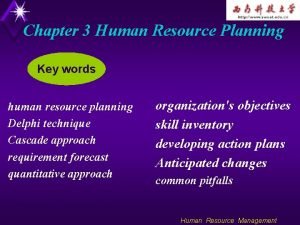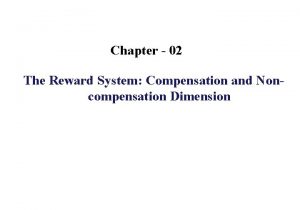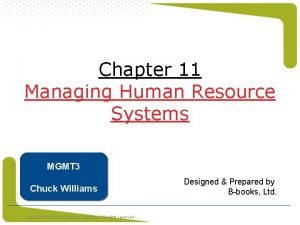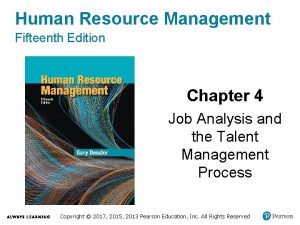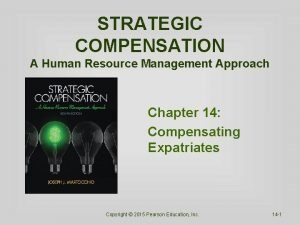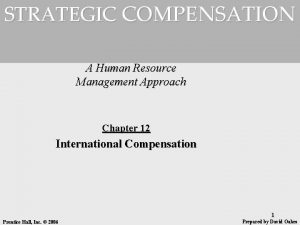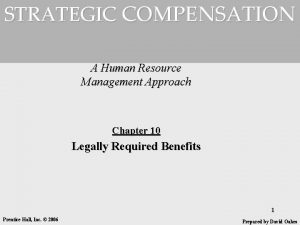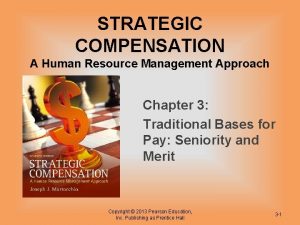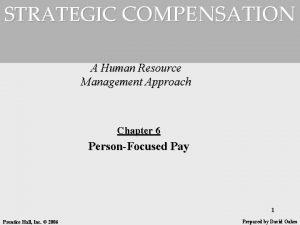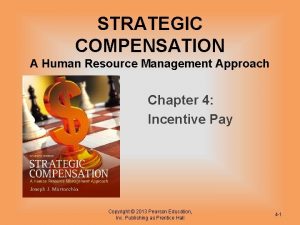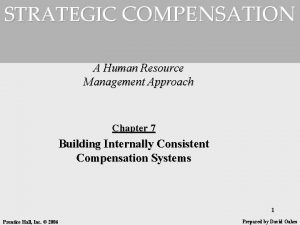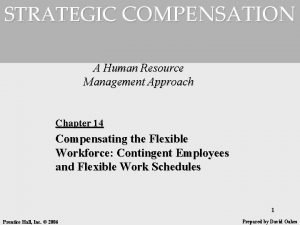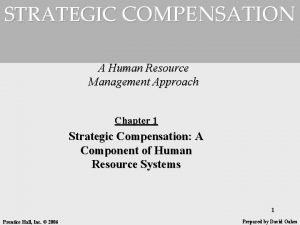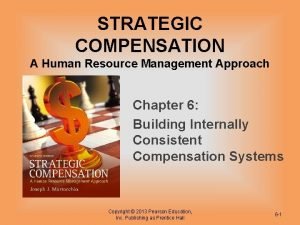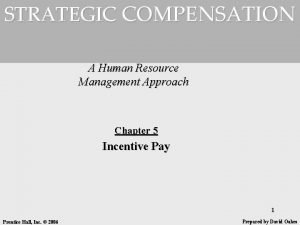STRATEGIC COMPENSATION A Human Resource Management Approach Chapter















- Slides: 15

STRATEGIC COMPENSATION A Human Resource Management Approach Chapter 1: Strategic Compensation: A Component of Human Resource Systems Copyright © 2013 Pearson Education, Inc. Publishing as Prentice Hall 1 -1

Learning Objectives 1. Basic compensation concepts and the context of compensation practice. 2. A historical perspective on compensation. 3. The difference between strategic and tactical compensation. 4. Compensation professionals’ goals within a human resource department. 5. How compensation professionals relate to various stakeholders. Copyright © 2013 Pearson Education, Inc. Publishing as Prentice Hall 1 -2

Learning Objective 1 Basic compensation concepts Copyright © 2013 Pearson Education, Inc. Publishing as Prentice Hall 1 -3

What Is Compensation? • Compensation represents the rewards employees receive for performing their job. They are either: – Intrinsic: intrinsic compensation represents employees’ critical psychological states that result from performing their jobs. – Extrinsic: extrinsic compensation includes both monetary and nonmonetary rewards. Copyright © 2013 Pearson Education, Inc. Publishing as Prentice Hall 1 -4

Elements of Core Compensation Base pay - Hourly pay - Annual salary Base pay adjustments - COLAs - Seniority pay - Merit pay - Skill-based pay - Incentive pay - Person-focused pay Copyright © 2013 Pearson Education, Inc. Publishing as Prentice Hall 1 -5

Base Pay Compensable Factors: • An employee’s skill level • An employee’s effort • An employee’s level of responsibility • The severity of the working conditions Copyright © 2013 Pearson Education, Inc. Publishing as Prentice Hall 1 -6

Base Pay Adjustments COLAs—COLAs represent periodic base pay increases that are founded on changes in prices as indexed by the consumer price index (CPI). Seniority Pay—seniority pay systems reward employees with periodic additions to base pay according to employees’ length of service in performing their jobs Merit Pay—merit pay programs assume that employees’ compensation over time should be determined, at least in part, by differences in job performance. Copyright © 2013 Pearson Education, Inc. Publishing as Prentice Hall 1 -7

Base Pay Adjustments (Cont’d) Incentive Pay—incentive pay (or variable pay) rewards employees for partially or completely attaining a predetermined work objective. Pay-for-Knowledge Plans—pay-for-knowledge plans reward managerial, service, or professional workers for successfully learning specific curricula Skill-based Pay—skill-based pay is used mostly for employees who perform physical work and increases these workers’ pay as they master new skills. Copyright © 2013 Pearson Education, Inc. Publishing as Prentice Hall 1 -8

Employee Benefits • Discretionary Benefits • Legally Required Benefits Copyright © 2013 Pearson Education, Inc. Publishing as Prentice Hall 1 -9

Discretionary Benefits Three Broad Categories: • Protection programs—provide family benefits, promote health, and guard against income loss caused by such catastrophic factors as unemployment, disability, or serious illness • Paid time-off—provides employees with pay for time when they are not working • Services—provides such enhancements as tuition reimbursement and day care assistance to employees and their families Copyright © 2013 Pearson Education, Inc. Publishing as Prentice Hall 1 -10

Legally-Required Benefits Federal Legislation Designed to: • • Promote worker safety and health Maintain family income Assist families in crisis Provide assistance in case of – Disability – Unemployment Copyright © 2013 Pearson Education, Inc. Publishing as Prentice Hall 1 -11

Summary Learning Objective 1 • • What is compensation? Elements of core compensation Base pay adjustments Employee benefits Discretionary benefits Legally-required benefits Copyright © 2013 Pearson Education, Inc. Publishing as Prentice Hall 1 -12

HR’s Role A quotation from Jay Hannah of Banc. First Corporation: “The HR department is the source and keeper of critical information, which is key in today’s workplace. With the information they provide, we in turn can build and design strategies to hire and retain the best workforce possible. And this may sound cliché, but it’s very true—the real competitive advantage is our company’s human resources. ” Copyright © 2013 Pearson Education, Inc. Publishing as Prentice Hall 1 -13

Human Resources Practices • Recruitment • Selection • Performance Appraisal • Training • Career Development • Labor-management relations • Employment termination • Insuring legal compliance Copyright © 2013 Pearson Education, Inc. Publishing as Prentice Hall 1 -14

Compensation Department’s Main Goals Compensation professionals promote effective compensation systems by meeting three important goals: • internal consistency • market competitiveness • recognition of individual contributions Copyright © 2013 Pearson Education, Inc. Publishing as Prentice Hall 1 -15
 Cascade approach in human resource management
Cascade approach in human resource management Compensation and non compensation dimensions
Compensation and non compensation dimensions Time management in human resource management
Time management in human resource management Assess human resource requirements of a retail organization
Assess human resource requirements of a retail organization Human resources defintion
Human resources defintion Human resource management strategy and analysis
Human resource management strategy and analysis Chapter 2 human resource management
Chapter 2 human resource management Chapter 9 human resource management
Chapter 9 human resource management Chapter 11 human resource management
Chapter 11 human resource management New approaches to organizing hr
New approaches to organizing hr Human resource management chapter 1
Human resource management chapter 1 Human resource management lecture chapter 1
Human resource management lecture chapter 1 Human resource management lecture chapter 1
Human resource management lecture chapter 1 Types of international assignment in ihrm
Types of international assignment in ihrm Chapter 4 job analysis and the talent management process
Chapter 4 job analysis and the talent management process Functions of hrm
Functions of hrm
